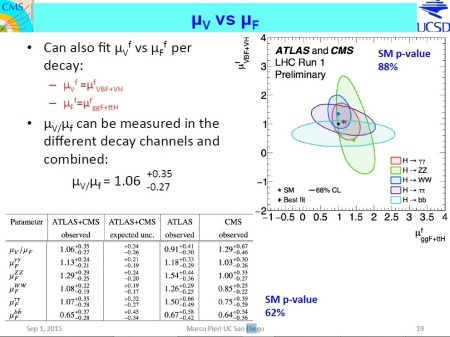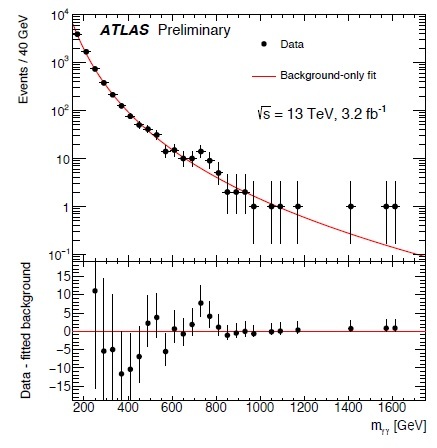
LHCP2016 is running yet with further analysis on 2015 data by people at CERN. We all have seen the history unfolding since the epochal event on 4 July 2012 where the announcement of the great discovery happened. Since then, also Kibble passed away. What is still there is our need of a deep understanding of the Higgs sector of the Standard Model. Quite recently, LHC restarted operations at the top achievable and data are gathered and analysed in view of the summer conferences.
The scalar particle observed at CERN has a mass of about 125 GeV. Data gathered on 2015 seem to indicate a further state at 750 GeV but this is yet to be confirmed. Anyway, both ATLAS and CMS see this bump in the  data and this seems to follow the story of the discovery of the Higgs particle. But we have not a fully understanding of the Higgs sector yet. The reason is that, in run I, gathered data were not enough to reduce the error bars to such small values to decide if Standard Model wins or not. Besides, as shown by run II, further excitations seem to pop up. So, several theoretical proposals for the Higgs sector still stand up and could be also confirmed already in August this year.
data and this seems to follow the story of the discovery of the Higgs particle. But we have not a fully understanding of the Higgs sector yet. The reason is that, in run I, gathered data were not enough to reduce the error bars to such small values to decide if Standard Model wins or not. Besides, as shown by run II, further excitations seem to pop up. So, several theoretical proposals for the Higgs sector still stand up and could be also confirmed already in August this year.
Indeed, there are great news already in the data presented at LHCP2016. As I pointed out here, there is a curious behavior of the strengths of the signals of Higgs decay in  and some tension, even if small, appeared between ATLAS and CMS results. Indeed, ATLAS seemed to have seen more events than CMS moving these contributions well beyond the unit value but, as CMS had them somewhat below, the average was the expected unity agreeing with expectations from the Standard Model. The strength of the signals is essential to understand if the propagator of the Higgs field is the usual free particle one or has some factor reducing it significantly with contributions from higher states summing up to unity. In this case, the observed state at 125 GeV would be just the ground state of a tower of particles being its excited states. As I showed recently, this is not physics beyond the Standard Model, rather is obtained by solving exactly the quantum equations of motion of the Higgs sector (see here). This is done considering the other fields interacting with the Higgs field just a perturbation.
and some tension, even if small, appeared between ATLAS and CMS results. Indeed, ATLAS seemed to have seen more events than CMS moving these contributions well beyond the unit value but, as CMS had them somewhat below, the average was the expected unity agreeing with expectations from the Standard Model. The strength of the signals is essential to understand if the propagator of the Higgs field is the usual free particle one or has some factor reducing it significantly with contributions from higher states summing up to unity. In this case, the observed state at 125 GeV would be just the ground state of a tower of particles being its excited states. As I showed recently, this is not physics beyond the Standard Model, rather is obtained by solving exactly the quantum equations of motion of the Higgs sector (see here). This is done considering the other fields interacting with the Higgs field just a perturbation.
So, let us do a recap of what was the situation for the strength of the signals for the  decays of the Higgs particle. At LHCP2015 the data were given in the following slide
decays of the Higgs particle. At LHCP2015 the data were given in the following slide

From the table one can see that the signal strengths for  decays in ATLAS are somewhat beyond unity while in CMS these are practically unity for
decays in ATLAS are somewhat beyond unity while in CMS these are practically unity for  but, more interestingly, 0.85 for
but, more interestingly, 0.85 for  . But we know that data gathered for
. But we know that data gathered for  decay are largely more than for
decay are largely more than for  decay. The error bars are large enough to be not a concern here. The value 0.85 is really in agreement with the already cited exact computations from the Higgs sector but, within the error, in overall agreement with the Standard Model. This seems to point toward on overestimated number of events in ATLAS but a somewhat reduced number of events in CMS, at least for
decay. The error bars are large enough to be not a concern here. The value 0.85 is really in agreement with the already cited exact computations from the Higgs sector but, within the error, in overall agreement with the Standard Model. This seems to point toward on overestimated number of events in ATLAS but a somewhat reduced number of events in CMS, at least for  decay.
decay.
At LHCP2016 new data have been presented from the two collaborations, at least for the  decay. The results are striking. In order to see if the scenario provided from the exact solution of the Higgs sector is in agreement with data, these should be confirmed from run II and those from ATLAS should go down significantly. This is indeed what is going on! This is the corresponding slide
decay. The results are striking. In order to see if the scenario provided from the exact solution of the Higgs sector is in agreement with data, these should be confirmed from run II and those from ATLAS should go down significantly. This is indeed what is going on! This is the corresponding slide

This result is striking per se as shows a tendency toward a decreasing value when, in precedence, it was around unity. Now it is aligned with the value seen at CMS for the  decay! The value seen is again in agreement with that given in the exact solution of the Higgs sector. And ATLAS? This is the most shocking result: They see a significant reduced set of events and the signal strength they obtain is now aligned to the one of CMS (see Strandberg’s talk at page 11).
decay! The value seen is again in agreement with that given in the exact solution of the Higgs sector. And ATLAS? This is the most shocking result: They see a significant reduced set of events and the signal strength they obtain is now aligned to the one of CMS (see Strandberg’s talk at page 11).
What should one conclude from this? If the state at 750 GeV should be confirmed, as the spectrum given by the exact solution of the Higgs sector is given by an integer multiplied by a mass, this would be at  . Together with the production strengths, if further data will confirm them, the proper scenario for the breaking of electroweak symmetry is exactly the one described by the exact solution. Of course, this should be obviously true but an experimental confirmation is essential for a lot of reasons, last but not least the form of the Higgs potential that, if the numbers are these, the one postulated in the sixties would be the correct one. An other important reason is that coupling with other matter does not change the spectrum of the theory in a significant way.
. Together with the production strengths, if further data will confirm them, the proper scenario for the breaking of electroweak symmetry is exactly the one described by the exact solution. Of course, this should be obviously true but an experimental confirmation is essential for a lot of reasons, last but not least the form of the Higgs potential that, if the numbers are these, the one postulated in the sixties would be the correct one. An other important reason is that coupling with other matter does not change the spectrum of the theory in a significant way.
So, to answer to the question of the title remains to wait a few weeks. Then, summer conferences will start and, paraphrasing Coleman: God knows, I know and by the end of the summer we all know.
Marco Frasca (2015). A theorem on the Higgs sector of the Standard Model Eur. Phys. J. Plus (2016) 131: 199 arXiv: 1504.02299v3
. Most commentators avoid to tell about this because it does not warrant click-bait anymore. At EPS-HEP 2019 in Ghent (Belgium), the following slide was presented by Hulin Wang on behalf of the ATLAS Collaboration
and no confirmation from CMS has ever arrived. We can just hope that the dreaming scenario takes life.




 Posted by mfrasca
Posted by mfrasca 


 known very precisely (see
known very precisely (see  Using their integral form and expressing all the correlation functions by momenta. It was an original view by
Using their integral form and expressing all the correlation functions by momenta. It was an original view by 


 problem in a near future. But of all the proposals Siegel is considering, he is missing the most promising one:
problem in a near future. But of all the proposals Siegel is considering, he is missing the most promising one: 

